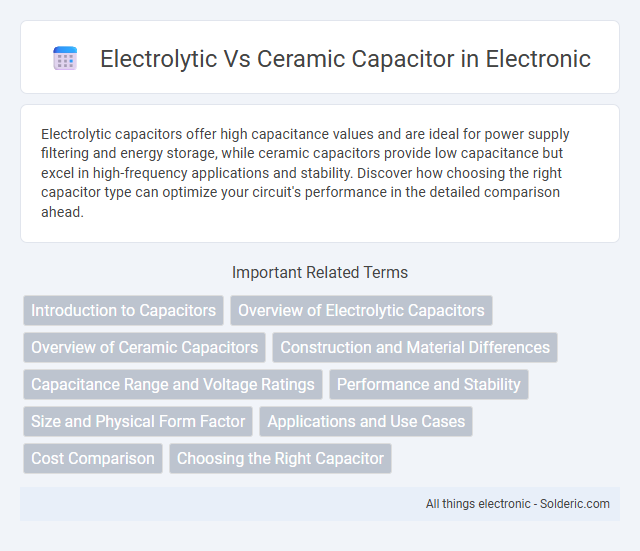Electrolytic capacitors offer high capacitance values and are ideal for power supply filtering and energy storage, while ceramic capacitors provide low capacitance but excel in high-frequency applications and stability. Discover how choosing the right capacitor type can optimize your circuit's performance in the detailed comparison ahead.
Comparison Table
| Feature | Electrolytic Capacitor | Ceramic Capacitor |
|---|---|---|
| Capacitance Range | 1uF to several thousand uF | 1pF to 10uF |
| Dielectric Material | Electrolyte (Aluminum or Tantalum) | Ceramic (Barium Titanate, etc.) |
| Voltage Rating | Typically 6V to 500V | Typically 16V to 500V |
| Polarization | Polarized (requires correct polarity) | Non-polarized |
| Frequency Response | Low to medium frequency | High frequency and RF applications |
| ESR (Equivalent Series Resistance) | Higher ESR | Low ESR |
| Size | Larger for same capacitance | Smaller size, compact |
| Applications | Power supply filtering, bulk energy storage | Decoupling, high-frequency filtering, signal processing |
| Lifetime | Shorter, electrolyte can dry out | Longer, more stable |
| Cost | Generally lower cost for high capacitance | Higher cost per uF |
Introduction to Capacitors
Capacitors store electrical energy through an electric field created between two conductive plates separated by a dielectric material. Electrolytic capacitors utilize an electrolyte as the dielectric, offering high capacitance values ideal for power supply filtering and audio applications. Ceramic capacitors use a ceramic material as the dielectric, providing low equivalent series resistance (ESR) and stability at high frequencies, making them suitable for signal coupling and decoupling.
Overview of Electrolytic Capacitors
Electrolytic capacitors are polarized components commonly used for high-capacitance applications in power supply filtering and energy storage. They feature an aluminum or tantalum anode coated with an oxide layer acting as the dielectric, allowing for large capacitance values within a compact size. Your choice of electrolytic capacitors affects circuit stability, ripple current handling, and lifespan, especially in audio or power electronics.
Overview of Ceramic Capacitors
Ceramic capacitors are non-polarized components made from ceramic materials that provide high-frequency performance and stability in electronic circuits. They offer low equivalent series resistance (ESR) and excellent capacitance stability over a wide temperature range, making them ideal for filtering, decoupling, and timing applications. Your designs benefit from their small size, reliability, and cost-effectiveness compared to electrolytic capacitors, which typically have higher capacitance but larger form factors and polarity restrictions.
Construction and Material Differences
Electrolytic capacitors utilize an aluminum or tantalum anode coated with an oxide layer acting as the dielectric, with an electrolyte serving as the cathode, which allows high capacitance in a compact size but results in polarity sensitivity. Ceramic capacitors consist of multiple layers of ceramic materials functioning as the dielectric, sandwiched between metal plates, enabling non-polarized operation and stable performance at high frequencies. The fundamental construction difference lies in the electrolytic capacitor's reliance on a liquid or gel electrolyte and oxide layer, while ceramic capacitors use solid ceramic dielectric materials for enhanced reliability and temperature stability.
Capacitance Range and Voltage Ratings
Electrolytic capacitors typically offer high capacitance values ranging from 1uF to several thousand microfarads, with voltage ratings commonly between 6.3V and 450V, making them ideal for power supply filtering and energy storage. Ceramic capacitors generally provide lower capacitance, usually from a few picofarads to several microfarads, but support much higher voltage ratings up to several kilovolts, which suits high-frequency and precision applications. Your choice between electrolytic and ceramic capacitors depends on the required capacitance and voltage tolerance for optimal circuit performance.
Performance and Stability
Electrolytic capacitors offer high capacitance values ideal for power supply filtering but exhibit higher equivalent series resistance (ESR) and limited stability over time and temperature variations. Ceramic capacitors provide excellent performance in high-frequency applications with low ESR and superior stability across wide temperature ranges, maintaining consistent capacitance and low dielectric losses. The choice between electrolytic and ceramic capacitors depends on the desired balance between capacitance, frequency response, and long-term reliability in electronic circuits.
Size and Physical Form Factor
Electrolytic capacitors typically have larger sizes and cylindrical shapes due to their construction and higher capacitance values, making them suitable for power supply filtering and bulk energy storage. Ceramic capacitors are smaller, often in compact, rectangular surface-mount packages that fit precisely into high-density circuit boards for high-frequency applications. You should consider the physical size and form factor based on your circuit's space constraints and performance requirements when choosing between these capacitor types.
Applications and Use Cases
Electrolytic capacitors are widely used in power supply filtering, audio equipment, and energy storage due to their high capacitance and voltage ratings, making them ideal for smoothing voltage fluctuations and bulk energy storage. Ceramic capacitors excel in high-frequency applications such as RF circuits, decoupling, and signal conditioning, thanks to their low equivalent series resistance (ESR) and excellent temperature stability. Choosing the right capacitor based on your circuit's requirements ensures optimal performance and reliability in applications ranging from consumer electronics to industrial machinery.
Cost Comparison
Electrolytic capacitors typically cost less per microfarad compared to ceramic capacitors, making them more economical for high-capacitance applications. Ceramic capacitors, while generally more expensive on a per-unit basis, offer better performance and reliability in low-capacitance, high-frequency circuits. Your choice depends on balancing cost with specific application requirements and performance needs.
Choosing the Right Capacitor
Choosing the right capacitor depends on your circuit's requirements for capacitance, voltage rating, and tolerance. Electrolytic capacitors offer high capacitance values ideal for power supply filtering but have higher equivalent series resistance (ESR) and shorter lifespans. Ceramic capacitors provide low ESR, excellent frequency response, and long-term stability, making them suitable for high-frequency applications and decoupling in sensitive electronic circuits.
Electrolytic vs Ceramic Capacitor Infographic

 solderic.com
solderic.com